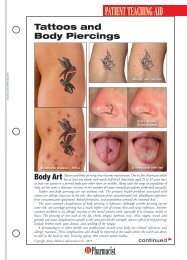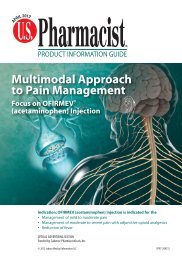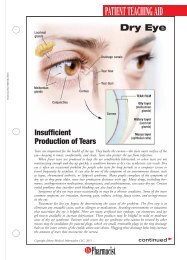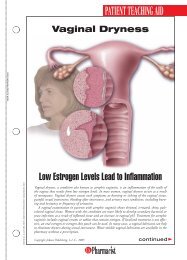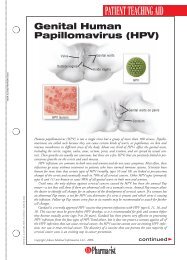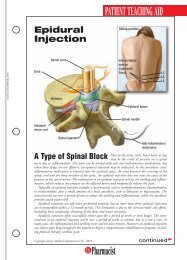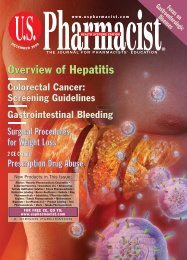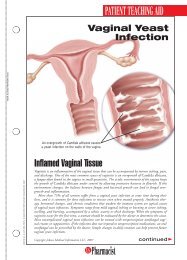View PDF Edition - U.S. Pharmacist
View PDF Edition - U.S. Pharmacist
View PDF Edition - U.S. Pharmacist
Create successful ePaper yourself
Turn your PDF publications into a flip-book with our unique Google optimized e-Paper software.
PROGRESSIVE SUPRANUCLEAR PALSYselective serotonin reuptakeinhibitors). 5,7 <strong>Pharmacist</strong>sshould note that prior toinitiating any treatment, theoverall benefit-to-risk ratioto the individual patientmust be considered.Due to adverse effectsassociated with dopamineagonists—including nausea,hypotension, confusion, andhallucinations—their utilityis severely limited. 4 Arecently published reassessmentof risks and benefits ofdopamine agonists in PD hasrevealed the occurrence of increasinglyrecognized adverse effectssuch as lower extremity edema,daytime somnolence, impulsecontrol disorders, and fibrosis. 13The antiviral agent amantadinewas accidentally discoveredto have an antiparkinsonismaction (e.g., increasing release ofdopamine among other effects). 4Adverse effects associated withamantadine therapy include restlessness,agitation, confusion,and hallucinations; high dosesmay result in an acute toxic psychosis.4 Peripheral edema, orthostatichypotension, urinary retention,dry mouth, and livedoreticularis (i.e., red to blue skindiscoloration on the limbs andtrunk that intensifies upon exposureto cold) may also occur. 1,4The geriatric patient populationmay be more susceptible toTable 2Dopamine Agonists Used in theTreatment of Parkinson’s Disease aApomorphine (Apokyn)Bromocriptine (Parlodel)Pramipexole (Mirapex)Ropinirole (Requip, Requip XL)Rotigotine transdermal (Neupro [DSC]) baRefer to manufacturer’s prescribing information for completedosing guidelines.bCurrently unavailable in the United States.Source: References 4, 14, 17.the central nervous system effectsof amantadine; the use of twodivided daily doses may minimizethis effect. 14 In patients with renalimpairment, amantadine requiresrenal dosing based on estimatedcreatinine clearance. Monitoringparameters for amantadine therapyinclude renal function, Parkinson’ssymptoms, mental status, andblood pressure. 14Nonpharmacologic measuresintroduced early in the course ofdisease may include weightedwalking aids or wheelchairs to preventfalls, and adaptive eyeglasses(e.g., bifocals, prisms) to improvevision. 2 Also important in theearly stage of the illness is theintroduction of physical therapy,occupational therapy, and speechtherapy as supportive measures. 2Thus far, surgical approaches toPSP have proven ineffective. 5A randomized, placebo-controlledtrial in Germany looked atthe short-term effects ofcoenzyme Q10 in PSP. 15Results indicated significantchanges in the occipital lobeand a consistent trend in thebasal ganglia. 15 Coenzyme Q10 treatment compared toplacebo showed clinicalimprovement according tothe PSP rating scale and theFrontal Assessment Battery;although the improvementwas slight, it was noted assignificant. 15 The researchersconcluded that since coenzyme Q10 appears to improve cerebralenergy metabolism in PSP, longtermtreatment might have a disease-modifying,neuroprotectiveeffect. 15ConclusionIn PSP, neurodegenerativechanges take place in the brainstem, basal ganglia, and elsewhere;neurofibrillary tangles arepresent. While PSP continues tobe an underrecognized disorderand is often misdiagnosed, it canbe differentiated from other akineticrigid syndromes such asPD. 5 Diagnosis of this debilitatingdisorder is clinical and treatment issupportive. Risks associated withpotential adverse effects of treatmentshould be considered in theformulation of an individualizedpharmaceutical care plan. Earlydiscussion about end-of-life issuesis advised.REFERENCES1. Beers MH, Porter RS, Jones TV, et al. The Merck Manualof Diagnosis and Therapy. 18th ed. Whitehouse Station,NJ: Merck Research Laboratories; 2006:1885.2. Progressive Supranuclear Palsy. In: Beers MH, JonesTV, Berkwits M, et al, eds. The Merck Manual of Geriatrics.Updated June 2006.www.merck.com/mkgr/mmg/sec6/ch46/ch46d.jsp.Accessed October 19, 2009.3. Craft S, Cholerton B, Reger M. Aging and cognition:what is normal? In: Hazzard WR, Blass JP, Halter JB, etal, eds. Principles of Geriatric Medicine and Gerontology.5th ed. New York, NY: McGraw-Hill, Inc; 2003:1355-1372.4. Howland RD, Mycek MJ. Pharmacology. 3rd ed.Philadelphia, PA: Lippincott Williams & Wilkins;2006:91-101.5. Lubarsky M, Juncos JL. Progressive supranuclear palsy:a current review. Neurologist. 2008 Mar;14(2):79-88.6. Beers MH, Jones TV, Berkwits M, et al, eds. TheMerck Manual of Health & Aging. Whitehouse Station,NJ: Merck Research Laboratories; 2004:367-369.7. Chand P, Litvan I. Progressive supranuclear palsy andcorticobasal degeneration: similarities and differences.Future Neurol. May 2008. www.medscape.com/viewarticle/578084.Accessed October 21, 2009.8. Zagaria ME. The dying patient: choices, control, andcommunication. U.S Pharm. 2009;34(10):32-34.9. Schneider A, Mandelkow E. Tau-based treatmentstrategies in neurodegenerative diseases. Neurotherapeutics.2008;5(3):443-457.10. Schmidt C, Herting B, Prieur S, et al. Autonomicdysfunction in patients with progressive supranuclearpalsy. Mov Disord. 2008;23(14):2083-2089.11. Litvan I, Campbell G, Mangone CA, et al. Whichclinical features differentiate progressive supranuclearpalsy (Steele-Richardson-Olszewski syndrome) fromrelated disorders? A clinicopathological study. Brain.1997;120(pt 1):65-74.12. Nelson MV, Berchou RC, LeWitt PA. Parkinson’s disease.In: DiPiro JT, Talbert RL, Yee GC, et al, eds. Pharmacotherapy:A Pathophysiologic Approach. 6th ed. NewYork, NY: McGraw-Hill, Inc; 2005:1075-1088.13. Antonini A, Tolosa E, Mizuno Y, et al. A reassment ofrisks and benefits of dopamine agonists in Parkinson’s disease.Lancet Neurol. 2009;8:929-937.14. Semla TP, Beizer JL, Higbee MD. Geriatric DosageHandbook. 14th ed. Hudson, OH: Lexi-Comp, Inc;2009.15. Stamelou M, Reuss A, Pilatus U, et al. Short-termeffects of coenzyme Q10 in progressive supranuclearpalsy: a randomized, placebo-controlled trial. Mov Disord.2008;23(7):942-949.16. Dorland’s Pocket Medical Dictionary. 28th ed. ElsevierSaunders; 2009.17. My Epocrates. Version 1.0. Updated October 6,2009.22U.S. <strong>Pharmacist</strong> • November 2009 • www.uspharmacist.com




